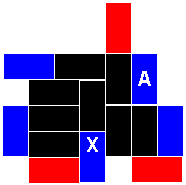The Domino Bead Game
This novel domino game was invented by Sid Sackson and discussed in his book A GAMUT OF GAMES (reprinted by Dover Books, ISBN 0-486-27347-4). Mr. Sackson is a world famous game inventor and was the guest of honor for 1989 at the Essener Speiltage, a European game enthusiasts and manufacturers trade show, held in Essen, Germany.
The name is a reference to Hermann Hesse's novel, Das Glasperlenspiel, translated as The Glass Bead Game (Magister Ludi).
Players and Equipment
The game uses a special set of 30 dominoes made by taking two identical double six domino sets and removing all the tiles in the zero and six suits. Mr. Sackson recommends using tiles with colored pips. It is also helpful to have a large board with a square grid whose cells are the same size as one half of a tile.
The game is for two, three or four players.
The Deal
The size of the hands varies with the number of players.
- Two players get 14 tiles each, with two tiles left over.
- Three players get 9 tiles each, with three tiles left over.
- Four players get 7 tiles each, with two tiles left over.
In the case of three left over tiles, one is put away out of the game and not exposed, to leave two tiles in the starter. The starter is the pair of left over tiles. These are turned face up and put side by side to make a square in the middle of the table.
If both of the starters are duplicate doubles, then it is a misdeal and you try again (the chances of this happening are 1 in 174 deals).
The Play
The first player is chosen by drawing dominoes from the boneyard. The highest total of pips plays first; ties are settled by drawing for highest total again. Play then rotates to the left.
The dominoes are placed on the grid, vertically or horizontally. The idea is to build a "crossword puzzle" grid of repeated number patterns in the rows and columns.
Any set two or more adjacent domino ends in a row or column is called a group. The tiles must be played so that the pips in each group form a (repeating) pattern. The possible patterns are:
- a single number repeated (a, a, a, ...),
- two numbers alternating (a, b, a, b, a, b, a, ...),
- three numbers in a repeating cycle (a, b, c, a, b, c, a, b, c, ...),
- four numbers in a repeating cycle (a, b, c, d, a, b, c, d, a, ...),
- or all five numbers in a pepeating cycle (a, b, c, d, e, a, b, c, d, e, a, ...).
As soon as a group has a repeated number in it, or contains all five numbers, the pattern for that group is fixed, and future tiles that extend the group must conform to the pattern.
As the layout grows, it is possible for a row or column to contain two or more groups, separated by spaces.
Each domino must be placed so that it correctly extends two or more groups, but you are not allowed create a set of four dominoes side by side in the layout, touching along their long sides. In the following diagram, where the existing tiles are shown in black, the blue positions are legal plays, provided that the pattern rules are observed, but the red positions are illegal. Note that in order to be legal, the tile end marked "X" would have to connect the groups to its right and left into a single group with a valid pattern, as well as correctly extending the group above it.

If a player thinks he cannot play, he exposes his hand. The other players can then (if they wish) point out any plays he might not have seen. In this case the player must play a tile. If more than one possible play is pointed out, the player has the option of picking the one he likes. If no play is pointed out, then the player scores zero and places no domino. He is not out of the game, but has to wait for his next turn to see if he can then find a play.
The game ends one of two ways:
- When one player dominoes. The other players who started after him get to place one more domino, however.
- When no player can place a tile.
Scoring
Scores are counted and added as the dominoes are placed. The score is the product of the new lengths of all extended groups. For example, adding the blue tile labelled "A" to the black tiles in the diagram above would score 80 points (4 x 5 x 4). If the domino used to extend the group is a double, the score is doubled.
All players lose points for the tiles remaining in their hands when the game is ended. Doubles are -5 points and all other tiles are -25 points.
Comments & Strategy
The game can also be played by two players who each start with identical sets of 15 dominoes (i.e. each player starts with a double six domino set and removes all the tiles in the zero and six suits).
Another variation is to expose all the hands at the start of the game. This leads to slower play, as people think about blocking the other players as well as their own strategy.
Some cells on the grid will become dead because there will be no single number which will satisfy patterns of all the groups that the cell would extend.